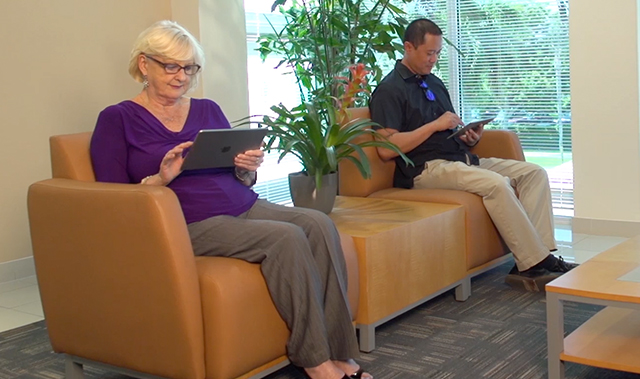Technology Can Give You the Edge on Engaging Patients

Why an EHR System, Patient Portal and Patient Kiosk Should be Part of the Equation
Using the right technology can help increase patient engagement and even boost provider rankings in our world of value-based care. Sounds intuitive and straightforward, so why is it still a struggle for so many providers?
Turns out there are important nuances. Increased patient participation in their own healthcare increases the likelihood for improved outcomes. Yet, engaging patients in a meaningful way requires making interactions with patients a simple streamlined and satisfying experience. In an ideal world of limitless resources and time, clinicians would naturally excel at engagement – focusing on patients is one of the reasons many providers chose medicine in the first place.
But in reality, clinical, face-to-face time with patients is often restricted by the pressures put on physicians nationwide. Do more with less, meet multiple regulations and, oh yeah, increase the time you spend on patient education and satisfaction while you’re at it.
Technology to the Rescue
Many of these tools already exist – including electronic health records (EHR) systems with patient portals, physician waiting rooms with patient kiosks. Clinicians willing to embrace these new advances could experience an easier transition to value-based healthcare in general, and, more specifically, meet the Merit Based Incentive Payment System (MIPS) requirements.
Knowing in advance some essential features of these technologies can make finding the right ones for your medical practice easier.
Patient Portals Create Expedited Communication
The most useful patient portals facilitate secure communication between physician and patient, allow more convenient and speedy access to test results and permit patients to request medication refills from their physician or pharmacy.
Patient portal information has to walk a fine line. It needs to be understandable for patients at different levels of reading aptitude as well as include the complex medical terminology for accuracy. The best patient portals make this challenge look simple.
Greater use of patient portals carries the potential for many benefits. Allowing patients to access their records can make them more informed. To increase patient engagement and use of the patient portal, educating them is crucial. Your practice and staff have to be a proponent of adopting the portal as well to gain the buy-in from your patients.
One of the ways to increase engagement should include talking to your patients to address any privacy or other concerns they may have about the use of patient portals. Another method to increase adoption could include promoting the availability of the portal to all patients. This can be accomplished by having pamphlets and signage in the waiting room, sending an email with the steps and reasons why it is beneficial and having the front office staff share any educational materials and process with patients as they check-in. It might even be necessary to take the time to walk patients through the process for the first time.
When a patient calls with a task they can complete themselves on the portal, instruct the staff to walk them through the process and let them know the patient portal is an option next time. An additional benefit to share is that through the Intramail messaging system, patients have another avenue to connect with their physician versus calling the practice. Having this messaging system as the primary way to communicate important information to your patients will help to increase portal usage. In the end, the more you use the portal as a practice, the more your patients will, too.
Paula Ubelhor, Insurance and Billing Manager at Randall Dermatology shared their practice’s experience regarding the value patient portal has brought to their dermatology practice. “We do have a lot of patients that use the Patient Portal. I feel like the best feature of the Portal is patients being able to review their results. Our patients really like being able to communicate with their provider and receive communication back from them. There’s more of a connection and loyalty when they can communicate electronically with their provider.”
Patient Kiosk Combines Greater Convenience and Accuracy
Speaking of greater accuracy associated with information coming directly from patients, an electronic check-in kiosk in a practice waiting room is another example. Instead of front-desk staff checking in patients, asking about any changes to insurance or contact information, making a copy of the insurance card and manually inputting the data, patient kiosks take data right from the source, the patient. This saves your staff valuable time and helps increase accuracy of the information collected as it comes directly from the patient. A patient, for example, is less likely to be off by one digit on a social security number or their address compared to a well-meaning office assistant who checks in 30 or more patients a day.
Similar to patient portals, the user experience is essential to engaging patients through kiosks. If a system is too tricky or confusing to navigate, many patients will tap on the waiting room window to ask for help or request the traditional paper and pen forms on a clipboard. The kiosk has to sit in a waiting room and be utilized by those of different levels of technological knowledge, backgrounds and ages.
Look for intuitive and inviting patient kiosks. When choosing a patient kiosk for your practice, request a demo and ask to speak to clients currently using the technology. Picture yourself as a new or returning patient and check out how long it takes and easy it is to check-in.
Many individuals are now accustomed to checking in on a kiosk at an airport. Those check-in kiosks have become more user friendly, and the technology you choose for your practice should at least be as intuitive, if not more so.
modmed® Kiosk excels in this arena of usability and this November received the People’s Choice Award from the UX Awards – a testament to its user-centered design and putting the end user, the patient, first.
Some practices provide patients with an iPad “kiosk” to check-in and confirm their information. Cleaver Dermatology is one such practice. Nathan Cleaver, DO, stated, “modmed Kiosk is simple to use and has saved us 10-15 minutes per new patient. Our medical staff can now focus on the patients and not on the paperwork.”





